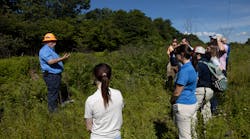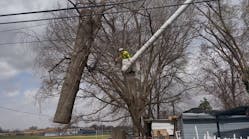Ask the Expert: Opportunities in Utility Vegetation Management
Best practices in utility vegetation management have been a topic of debate for decades. From mechanized mowing practices to chemical control methods, professionals today have more technology, equipment and products at their disposal than ever before.
As an active leader in vegetation management products and solutions, Corteva Agriscience connects with industry experts across the country to align on best practices for right-of-way management, identify environmental and economic implications of different vegetation control methods, and address the evolving needs of industry practitioners. Most recently, Corteva partnered with like-minded industry leaders to present the 2022 ROW Sustainability Summit, where the organization’s industry experts connected with Lew Payne, ROW environmental manager with New York Power Authority.
During the discussion, Payne shared insights that align with recommendations and resources developed by Corteva, including the following:
· The cost efficiency of Integrated Vegetation Management programs over exclusive mowing practices
· Best practices for habitat management throughout energy rights-of-way
· The role of vegetation management in Environmental, Social and Governance (ESG) reporting
Read Payne’s input below for more details:
What makes utility rights-of-way (ROW) such valuable assets for conservation?
Lew Payne (LP): Utility ROW offer an opportunity for early successional stage habitat to develop. Once powerline corridors are established, we can keep other developers out and protect the early successional habitat that can thrive out here.
When you think of best management practices, what comes to mind and why?
LP: Integrated Vegetation Management practices represent the ways we like to manage our ROW. We’re not just utility foresters; we’re land managers. So we’re managing beyond safety, reliability and the environmental aspects. We’re really focused on sustainability as a whole and IVM helps us achieve our objectives.
How can the use of best practices for vegetation management help address concerns from adjacent landowners or other public entities?
LP: There’s definitely a social aspect to it. From an education standpoint, we’re teaching applicators, ROW managers, landowners, regulators and internal stakeholders our management strategies and habitat management objectives. That way, we all understand what’s happening out on the ROW. We’ve also put kiosks out to show our industry and public partners what we’re doing and the biodiversity that our practices are creating throughout our managed land.
How would you describe IVM and what it brings to the table for energy companies?
LP: IVM adds a number of tools to your toolbox. There are herbicides; there are biological controls; there are cultural methods; there are mechanical methods. Herbicides are a really important tool for IVM programs, but you can also accomplish desirable results with or without them, depending on the vegetation you are targeting and the objectives of your program.
How would you describe the impact IVM has on maintenance costs and annual resource management?
LP: I can build a long-term vegetation management plan that covers my whole system using IVM. Once everything is set up properly, my costs are going to come down over time and the amount of herbicide I apply per acre is going to be reduced as well. If you start mowing more often, noncompatible plants will come back in full force and you’ve got to mow more frequently, which will bring your costs back up.
In your opinion, what are the most significant differences between IVM practices and the strategy of mowing exclusively?
LP: With mowing, it’s quite likely that you’ll negatively impact biodiversity. You’re going to destroy nectar resources for the pollinators and nesting habitat areas for songbirds. Mowing also opens up ground cover, which causes amphibians and reptiles to not like it out here. From an environmental sustainability standpoint, you really need to go with IVM over mowing exclusively.
Watch as Lew Payne of New York Power Authority explains how the state-owned transmission utility company uses Integrated Vegetation Management practices to manage right-of-way corridors with pollinators in mind.
How do you envision your program transforming in the coming years?
LP: One thing that we’re looking at right now is applying herbicides with drones. We’re actually in the process of applying a selective method where we’re spraying individual stems as well as some broadcast spraying on paths where we mowed underneath conductors. We’re going to continue focusing on advancements in technology that help us improve our program over time.
What opportunities exist for energy companies to contribute to Environmental, Social and Governance (ESG) reporting through the way they manage ROW corridors?
LP: There are tremendous opportunities. In addition to the biodiversity aspect, we’re looking at the equipment we put out here. We’re also monitoring our fossil fuel usage and switching our strategies to limit our carbon footprint. All of this can roll up into ESG targets and increase education regarding our need to keep herbicides as a tool that can help us develop and maintain rich biodiverse habitat out on the ROW.
For more information on using IVM-based strategies to control undesirable plant species, promote low-growing vegetation and enhance environmental sustainability, visit HabitatWithHerbicides.com.
For additional insights regarding New York Power Authority and the role IVM plays in the company’s transmission of its ROW vegetation management program, click here.
™ ® Trademarks of Corteva Agriscience and its affiliated companies. © 2022 Corteva.
Sponsored By:



